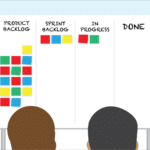Agile teams have been struggling since the earliest days with how to bring new people on to a team. In one of the first Agile books, there was a story of Alistair Cockburn walking a new hire through the team’s flip charts and telling the story of their work. I haven’t seen a team use […]
Scrum
Scrum by Example – Is Your Scrum Team a Victim of Scrummerfall?
Is your Scrum team struggling with questions about who owns quality? Is testing way behind development? Are team members claiming no time for retrospective because they’re focused on delivery? They might be victims of what some call Scrummerfall, or Mini Waterfall. Let’s use our fictional World’s Smallest Online Bookstore (WSOBS) Scrum team to explore what […]
The Modern Guide to the Daily Scrum Meeting
Many people who attend Scrum training courses start with the impression that the Daily Scrum is the whole of Scrum. Others think the Daily Scrum centres on three questions (this was true a long time ago). This guide to the Daily Scrum meeting was created to address these misconceptions as well as answer common questions. […]
Scrum by Example – How Sprint Planning Mistakes Can Derail a Team
Sprint Planning is the most underappreciated Agile event. Unfortunately, that leads to a whole host of errors and problems, as we will soon see. The ScrumGuide says: “Sprint Planning initiates the Sprint by laying out the work to be performed for the Sprint. This resulting plan is created by the collaborative work of the entire […]
What is the Recommended Scrum Team Size?
Nearly every client I work with asks me this question at some point. The Scrum Guide offers very limited guidance, suggesting 3-9 people per team (exclusive of ScrumMaster and Product Owner), without giving reasons or context for those numbers. There isn’t one universally correct answer for optimal team size, but there are a number of […]
Scrum Anti-Patterns – How We Hold Back Our Scrum Teams
In software development work, a design pattern is a description of a solution to a recurring problem. It outlines the elements that are necessary to solve the problem, including context and the consequences of certain actions, without prompting the reader to solve the problem a specific way, leaving them with the agency to write code […]
Scrum Anti-Patterns: Micromanagement
A design pattern is a description of a solution to a recurring problem. It outlines the elements that are necessary to solve the challenge without prompting the reader to address the issue in a specific way. Unfortunately, we also regularly see recurring patterns of ineffective behaviour. These are called Anti-Patterns. The following is an exploration […]
What Are the Limits of the Scrum Framework?
Frequently in workshops, I get asked, “Where shouldn’t we use Scrum?” The short answer is there are lots of instances where the Scrum framework doesn’t fit. However, to give a more complete and effective answer to this question, first we need to have an idea of why and when Scrum does work and what the […]







